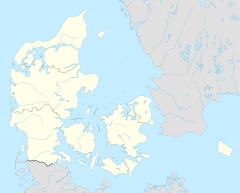Rosenborg Castle
| Rosenborg Castle | |
|---|---|
 Rosenborg Castle seen from the Castle Gardens | |
| General information | |
| Architectural style | Dutch Renaissance |
| Town or city | Copenhagen |
| Country | Denmark |
| Coordinates | 55°41′8″N 12°34′40″E / 55.68556°N 12.57778°E |
| Construction started | 1606 |
| Completed | 1624 |
| Client | Christian IV |
| Design and construction | |
| Architect(s) | Hans van Steenwinckel the Younger, Bertel Lange |
Rosenborg Castle (Danish: Rosenborg Slot) is a renaissance castle located in Copenhagen, Denmark. The castle was originally built as a country summerhouse in 1606 and is an example of Christian IV's many architectural projects. It was built in the Dutch Renaissance style, typical of Danish buildings during this period, and has been expanded several times, finally evolving into its present condition by the year 1624. Architects Bertel Lange and Hans van Steenwinckel the Younger are associated with the structural planning of the castle.
History

The castle was used by Danish regents as a royal residence until around 1710. After the reign of Frederik IV, Rosenborg was used as a royal residence only twice, and both these times were during emergencies. The first time was after Christiansborg Palace burned down in 1794, and the second time was during the British attack on Copenhagen in 1801.
Architecture
Long Hall

Located on the third floor, the Long Hall was completed in 1624. It was originally intended as a ballroom. Around 1700 it was used as Royal Reception Room and for banquets. It was not until the second half of the 19th century that it became known as the "Knight's Hall".
Among the main attractions of Rosenborg are the coronation chair of the absolutist kings and the throne of the queens with the three silver lions standing in front. The Long Hall also contains a large collection of silver furniture, of which most is from the 17th century.[1]
Rosenborg Collections
The castle is open to the public for tours and houses a museum exhibiting the Royal Collections, artifacts spanning a breadth of royal Danish culture, from the late 16th century of Christian IV to the 19th century. Some of these articles once belonged to the nobility and the aristocracy. The castle, now state property, was opened to the public in 1838.
Of special interest to tourists is a treasury displaying the
Gardens
The castle is situated in
Gallery
-
Frontal view
-
View from the west
-
Right view
-
Rear of Rosenborg Castle
-
Crown of Christian IV. On display at the castle
-
Denmark's globus cruciger. On display at the castle
-
The royal baptismal set. On display at the castle
See also
References
- ^ "The Long Hall, The Knights' Hall". Rosenborg Castle. Retrieved 2010-01-06.[permanent dead link]
External links
 Media related to Rosenborg Castle at Wikimedia Commons
Media related to Rosenborg Castle at Wikimedia Commons- Copenhagen-Portal - Rosenborg Castle and History Archived 2010-09-21 at the Wayback Machine
- Official site
- The Association of Castles and Museums around the Baltic Sea










